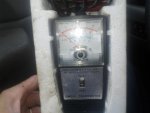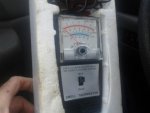I have lots of questions and I am sorry for the long post. This is my first time timing an engine so I want to make sure I am doing it right.
I have a 1984 3.0L Mercruiser engine, with a points ignition. I have been reading the timing instructions and I want to see if I understand this.
#1- It says in the Mercruiser service manual #3 to use a jumper wire and connect the 2 white wires together. I look at my engine, and I do not have 2 white wires coming from the dist, but a single black wire running to the coil. I am thinking that my engine year was before they had the 2 white wires, so I don't need to do this?
#2- It says that I need to set my timing at 6 degrees BTDC. Once that is obtained, tighten down the clamp and I am done. However the 3.0L engines with the white wires says to set it at 6*, then when you disconnect the white wires, it should be at 12*. Since I do not have the white wires, should I set it at 12* or 6*?
#3- After watching an MSD timing video online, it says I need to set the idle timing, then rev the engine until it stops advancing, and then set it to "specification" if it is not already at specification. Which would be 35 degrees 29+6 according to the manual chart. Do I need to set the total timing on these engines, or do you just set the idle timing and stop?
#4- should the timing be set when the boat is in the water, or can it be done on the trailer?
#5- Last night I used a timing gun, and set the timing to 6* BTDC. The engine idles nice and seems to smooth out. However after setting that, when I rev the engine up using quick revs, it bogs and dies fairly quick. This is why I am wondering if I needed to set the total timing.
#6- After I set the timing where I want it to be, I kill the engine, and hold the Dist cap with my hand and tighten down the clamp. After tightening down the clamp and starting the motor again, the timing is now about 2 degrees off in either direction. is there a trick to tightening down the clamp while keeping the timing in the exact same place. I tried it almost 4-5 times, and every time, the timing was either 8, or 4 after I tightened the clamp.
Thanks for any help on this.
I have a 1984 3.0L Mercruiser engine, with a points ignition. I have been reading the timing instructions and I want to see if I understand this.
#1- It says in the Mercruiser service manual #3 to use a jumper wire and connect the 2 white wires together. I look at my engine, and I do not have 2 white wires coming from the dist, but a single black wire running to the coil. I am thinking that my engine year was before they had the 2 white wires, so I don't need to do this?
#2- It says that I need to set my timing at 6 degrees BTDC. Once that is obtained, tighten down the clamp and I am done. However the 3.0L engines with the white wires says to set it at 6*, then when you disconnect the white wires, it should be at 12*. Since I do not have the white wires, should I set it at 12* or 6*?
#3- After watching an MSD timing video online, it says I need to set the idle timing, then rev the engine until it stops advancing, and then set it to "specification" if it is not already at specification. Which would be 35 degrees 29+6 according to the manual chart. Do I need to set the total timing on these engines, or do you just set the idle timing and stop?
#4- should the timing be set when the boat is in the water, or can it be done on the trailer?
#5- Last night I used a timing gun, and set the timing to 6* BTDC. The engine idles nice and seems to smooth out. However after setting that, when I rev the engine up using quick revs, it bogs and dies fairly quick. This is why I am wondering if I needed to set the total timing.
#6- After I set the timing where I want it to be, I kill the engine, and hold the Dist cap with my hand and tighten down the clamp. After tightening down the clamp and starting the motor again, the timing is now about 2 degrees off in either direction. is there a trick to tightening down the clamp while keeping the timing in the exact same place. I tried it almost 4-5 times, and every time, the timing was either 8, or 4 after I tightened the clamp.
Thanks for any help on this.























